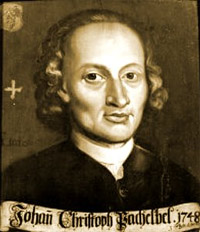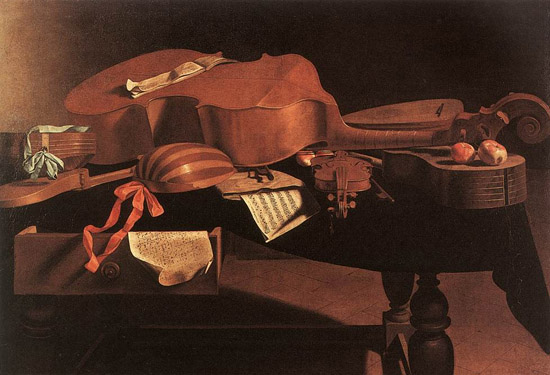Like Allegri, whose famed Miserere eclipsed everything
else he achieved in his career, Johaim Pachelbel's name is
automatically linked to the ever-popular three-part Canon in D. Born in Nuremberg in the autumn of 1653, Pachelbel showed
an early appetite for learning. In addition to school, he had two
music teachers, one who introduced him to the fundamentals of
music while the other taught him to play and compose. He was
briefly at the University of Altdorf before taking a position in
1673 as assistant organist at the cathedral of St Stephen in
Vienna. Four years later he became the court organist to the Duke
of Saxe-Eisenach. He became restless here, and requesting a letter
of reference from his employers, left after a year. His reference
described him as a "rare and perfect virtuoso."
Subsequently Pachelbel became the organist at the Erfurt
Predigerkirche, where he spent 12 happy years. His first wife
succumbed to the plague, but within a year he had remarried and
subsequently had seven children. This period was a time of
increasing contentment and creative growth. In 1690, he became
organist in Stuttgart at the Wurttemberg Court. The threat of a
French invasion curtailed this position two years later, and
Pachelbel returned to his home town of Nuremberg to take up the
post of organist at St Sebald. There he lived out his final decade
writing ever more imposing works.
It is not known when Pachelbel composed his famous Canon.
The work is scored for three violins and continue», each
violin entering in turn and elaborating on a simple theme as the
piece gathers in strength and builds to a climax. But Pachelbel's
importance is, in fact, perhaps greater as a composer for the
organ; his chorale preludes, based on hymn tunes, strongly
influenced J.S. Bach. He was also the author of a great many
motets, arias, and Masses, and 13 Magnificats which feature solo
singers and a choir as well as an orchestra often including wind
and brass. His body of work reflects the cultural contrasts
between his own Protestant ways and those of the higher Church,
and certainly deserves to be known at least as well as his
celebrated Canon.
|



No comments:
Post a Comment